Exploring Vertical Rotisserie Spits: Techniques and Benefits
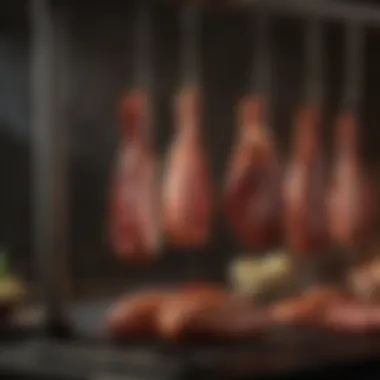
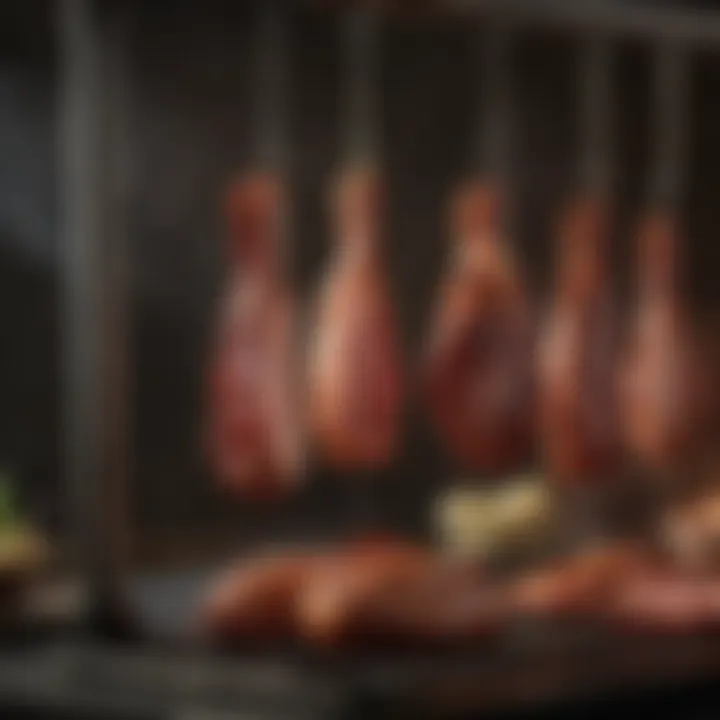
Intro
The art of cooking is replete with techniques that do more than just fill our stomachs; they create an experience. Among these techniques, vertical rotisserie spits stand out, marrying tradition with modern flavors. They offer a unique way to prepare meat, capturing juices and amplifying tastes in a way that few other methods can. Whether one is roasting a succulent chicken or experimenting with exotic spices on lamb, understanding the ins and outs of vertical rotisserie spits can elevate home kitchens to new culinary heights.
Much like a painter uses a canvas, chefs utilize vertical rotisserie spits as a way to express their creativity and hone their skills. The interplay of heat and time merges beautifully in this cooking style, resulting in dishes that not only please the palate but also beckon diners to partake in the sensory experience.
This article delves deeper into the techniques, benefits, and culinary applications of vertical rotisserie spits, providing a comprehensive understanding for both novice and seasoned cooks alike. So, roll up your sleeves; it’s time to take a deeper look into this fascinating world of cooking that just might inspire your next meal.
Technique Overview
Vertical rotisserie cooking thrives on the principle of even heat distribution. As the meat rotates, heat envelops it from all angles, ensuring nothing is left undercooked. This method relies heavily on a few key components:
- Heat Source: This can be charcoal, gas, or electric, each providing a unique flavor profile. Charcoal often lends a smokiness that is hard to replicate.
- Rotisserie Mechanism: The system that securely holds the meat and allows it to turn. This can range from manual to motorized options, depending on your kitchen setup.
- Drip Pan: A crucial element for catching flavorful drippings, which can later be transformed into sauces or gravies.
It's worth noting that certain meats, like whole chickens or kebabs, shine particularly well when cooked on a spit. Each type of meat may require different approaches and cooking times, which we will explore further in the article.
Benefits of Vertical Rotisserie Cooking
Using a vertical rotisserie spit isn’t just about the cooking method; it comes with a plethora of benefits:
- Flavor Enhancement: The continual basting of meat in its own juices results in deeper, richer flavors that infuse the dish.
- Healthier Cooking: As meat rotates and constant heat circulates, excess fat drips away, making for leaner, less greasy meals.
- Efficient Cooking Times: Vertical cooking techniques can reduce cooking times significantly without sacrificing taste or texture.
- Convenience: While the meat cooks, you can focus on preparing sides or even enjoying a glass of wine, knowing that the spit is doing its work.
"The true beauty of cooking with a vertical rotisserie is in how it allows the cook to multitask; it’s a harmonious blend of art and efficiency."
Culinary Applications
Vertical rotisserie cooking is not limited to one type of cuisine; it lends itself beautifully to so many culinary traditions. Here’s a glimpse at just a few applications:
- Middle Eastern Shawarma: Slices of marinated meat layered and stacked on a vertical spit. As it cooks, the outer layer crisps while the inner meat remains juicy.
- Greek Gyros: Traditionally made from pork, this dish showcases how well-seasoned meat can shine when cooked vertically, providing an easy-to-serve option that pairs wonderfully with pita and tzatziki.
- Mexican Al Pastor: This preparation involves marinating pork in a mixture of spices and pineapple juice, then stacking it on the spit, often topped with a pineapple for added sweetness.
- Classic Rotisserie Chicken: A staple in many households, nothing quite ties together a family meal like a perfectly seasoned, golden-brown chicken.
With such a wide range of culinary possibilities, there’s no doubt that vertical rotisserie spits can easily find a place in anyone's kitchen.
Finale
In the ever-evolving world of gastronomy, vertical rotisserie spits are a testament to the beautiful blend of tradition and modern flavors. Understanding the techniques, benefits, and varied culinary applications related to this cooking method is not just useful but essential for any aspiring chef. With the right knowledge and practice, the flavorful advantage offered by vertical spits can enhance both daily meals and special gatherings, serving as a unifier around the dining table.
Prolusion to Vertical Rotisserie Spits
The art of cooking on vertical rotisserie spits has gained traction in home kitchens, and for good reason. There's a particular charm to watching meat roast slowly, its juices self-basting as it turns. This section sheds light on the fascinating world of vertical rotisserie spits, covering their key attributes, distinctive benefits, and noteworthy considerations that come into play when using this tool.
Definition and Purpose
A vertical rotisserie spit is a cooking apparatus designed to hold various types of meat in a vertical position, exposing them to heat while they rotate. The primary purpose of this method is to achieve an even distribution of heat around the food, allowing it to cook uniformly. This technique prevents drying out, enhances flavor, and helps achieve that coveted golden-brown crust that many cooks desire.
In essence, these spits transform how we approach the cooking process. Rather than relying solely on direct heat from a grill, the rotisserie method employs radiant heat, lending itself to methods that promote richer flavors and juicier outcomes. Cooks can venture beyond just roasts; there's creativity to be had with vegetables and even smaller game meats.
Historical Context
The concept of rotating meat over a heat source dates back centuries, tracing its roots to ancient civilizations. In Europe, for instance, early forms of spits were prevalent in medieval kitchens, where a rotating rod was often manually turned, making it labor-intensive but effective. These spits were typically made of iron or wood, and chefs would set them near the fireplace to harness the positioning for optimal cooking.
As cooking technology evolved, so did the design of the rotisserie spit. The introduction of mechanized options during the industrial revolution brought a less labor-intensive approach. Enter the electric and gas-powered spits, which now populate modern backyards and professional kitchens alike. Today, with both simple and advanced designs available, vertical rotisserie cooking is accessible to all home cooks—becoming a beloved fixture in culinary practices around the world.
"The history of the vertical rotisserie is a testament to humanity's tireless quest for the ideal cook!"
Understanding this evolution is key—it allows cooks to appreciate the sophisticated techniques we often take for granted, and it highlights the spit not just as a tool, but as a bridge connecting culinary tradition with modern flavor innovation.
Components of a Vertical Rotisserie Spit
When considering the landscape of cooking, few devices can match the charm and efficiency of the vertical rotisserie spit. Understanding its components is crucial as these individual elements work in harmony to deliver delicious results. From cooking techniques to flavor retention, each part of the spit contributes significantly to the overall experience. Here’s a closer look at what makes these varieties of spits tick.
Spit Rod and Forks
The spit rod serves as the backbone of the vertical rotisserie, acting like a sturdy spine that holds everything in place. Typically made of durable materials, this rod can withstand the weight of hefty meats while rotating uniformly. The forks, which are attached to the rod, play a pivotal role in securing the meat firmly during cooking. This is not a one-size-fits-all situation; when selecting forks, one must consider the type of meat being cooked.
For instance, spiky forks provide a secure hold for heavier cuts, while more delicate designs work wonders with smaller poultry.
Heating Element Types
The variety of heating elements available for vertical rotisserie spits allows for great flexibility in cooking styles. Each type has its unique set of advantages and applications.
Gas vs. Electric
When it comes to cooking, gas and electric heating elements each have fervent advocates. Gas-powered spits are often celebrated for their rapid heating capabilities. They deliver a robust flame that can infuse your meat with a smoky profile, ideal for outdoor settings. The immediate heat also ensures that meats caramelize beautifully, enhancing the overall flavor.
On the flip side, electric options boast convenience and precision.
Though they may lack that charred flavor, they provide steady temperatures and ease of use, making them an excellent choice for those who prefer hasslefree indoor cooking. Choosing between these two often comes down to personal preference and cooking context.
Charcoal Options
Charcoal remains a traditional choice for many, breathing life into cookouts and backyard barbecues. The charm of cooking over charcoal lies in its ability to absorb and radiate heat slowly, resulting in deeper flavors and higher juiciness. This slow-cooking method appeals to those who appreciate the nuances in flavors that wood and charcoal impart.
However, charcoal does require more active management, from lighting to sustaining its burning.
This added effort can deter some, but for many, it’s a price worth paying for the authentic taste experience.
Base Materials and Design
The design of a vertical rotisserie spit significantly impacts its functionality. Most of these devices are manufactured from stainless steel or high-grade aluminum, ensuring durability and resistance to corrosion.
The base is especially important as it must provide stability while supporting the considerable weight of meats. Factors like mobility, whether the spit is mobile or stationary, also play a role in overall usability.
Moreover, aesthetic features may attract culinary connoisseurs looking for a statement piece in their kitchen or outdoor space.
Rich finishes and thoughtful designs can elevate the overall cooking experience.
In sum, the components of a vertical rotisserie spit are not just add-ons; they are integral to the cooking process. Knowing how each element contributes can help you select the right spit for your needs, enabling you to maximize your culinary creations.
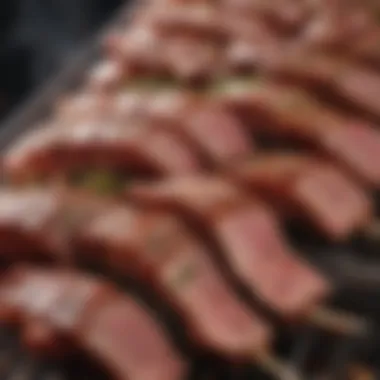
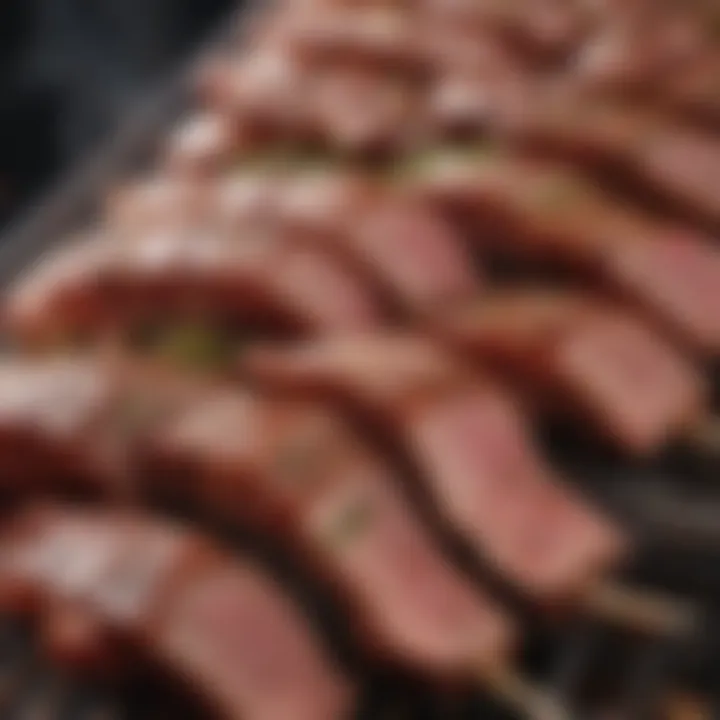
Operational Mechanics of Vertical Rotisserie Spits
Understanding the operational mechanics of vertical rotisserie spits is crucial for anyone looking to master this cooking technique. These mechanics dictate how heat is applied, how food is cooked evenly and effectively, and ultimately, how delicious the end results are.
Cooking Method Explained
At its core, the cooking method employed by vertical rotisserie spits revolves around the principle of radiant heat combined with convection currents. Unlike traditional horizontal grilling methods, where heat is applied from below, vertical spits allow for a more even distribution of heat around the food. The continuous rotation of the spit ensures that every side of the meat is exposed to heat evenly, resulting in a succulent and perfectly browned exterior.
To utilize a vertical rotisserie spit effectively, the food—typically marinated meats or vegetables—is placed securely around the spit rod. As the spit rotates, gravity plays a role too; juices from the meat continuously baste the exterior, keeping it moist while the interior cooks through. This technique not only enhances flavor but also contributes to a tender texture that’s hard to achieve with other methods.
Heat Distribution Dynamics
Heat distribution is a fundamental factor in achieving that mouthwatering rotisserie effect. In a vertical rotisserie, heat is supplied from either the bottom or the sides, creating a unique cooking environment. This setup harnesses natural convection, where the heated air rises and circulates around the food, leading to consistently cooked dishes.
- Bottom Heat: When heat is supplied from below, the bottom of the meat cooks more quickly. This can create a caramelized crust while allowing gravity to help the juices flow downwards, continually moistening the meat.
- Side Heat: Heating from the sides tends to result in a more uniform cooking process. As hot air circulates around the food, it enhances browning while preventing hot spots that could lead to uneven cooking.
"A well-placed heat source can make all the difference. In vertical rotisserie cooking, heat application innovations give chefs the upper hand in flavor and moisture retention."
Rotation Speed and Its Impact
The rotation speed of the spit is not just a technical specification; it profoundly influences the cooking process. Faster speeds generally promote better browning and crisping on the meat’s surface while allowing the interior to cook through without over-drying. Conversely, a slower rotation can enhance tenderness as it allows the meat more time to baste in its own juices.
Factors to consider regarding rotation speed include:
- Meat Type: Denser cuts like beef may require a slower rotation for thorough cooking.
- Desired Texture: If aiming for a crispy skin, a faster rotation may help achieve that golden appearance while mitigating excess fat dripping.
- Cooking Time: Adjusting the speed can also fine-tune how quickly meals are prepared, making it essential in time-sensitive cooking scenarios.
Advantages of Using Vertical Rotisserie Spits
When it comes to cooking meat in a way that maximizes flavor and juiciness, vertical rotisserie spits are an impressive asset. Their design and functionality offer several key advantages that cater to both amateur cooks and seasoned chefs alike. This section dives deep into the unique benefits these spits bring to the table, focusing on flavor enhancement strategies, cooking efficiency, and healthier options that won't compromise on taste.
Flavor Enhancement Strategies
One of the most compelling reasons to use a vertical rotisserie spit is the unparalleled flavor they can add to your dishes. The nature of vertical cooking allows fats to drip away from the meat as it rotates, which enhances the browning and caramelization of its surfaces.
- Basting Options: The rotisserie method naturally keeps meat moist, and the rotation ensures even basting if you're using marinades or mop sauces. This continual application enhances flavors, keeping a beautiful, succulent profile.
- Herb Infusion: As the meat cooks, herbs or spices can be added to the drip tray, allowing their flavors to rise and envelop the meat, creating a complex taste profile.
- Smoky Flavors: For those who love grilling, adding wood chips to the heat source during cooking adds a distinct smoky taste that elevates the dish.
The combination of these methods can turn an average meal into something quite exquisite, making each bite a culinary delight.
Efficient Cooking Times
When time is of the essence, vertical rotisserie spits shine with their efficient cooking capabilities. The design allows for a greater surface area to be exposed to heat, which tends to reduce cooking times significantly.
- Even Cooking: The rotation ensures that each part of the meat gets adequately cooked, which can often prevent the dreaded dry spots that are common in traditional roasting.
- Batch Cooking: Vertical rotisserie spits can accommodate multiple pieces of meat at once. Whether you're hosting a gathering or meal prepping for the week, you can prepare several chickens or skewers simultaneously without sacrificing quality.
- Consistent Results: As the spit continually rotates, it helps in achieving an even golden-brown finish, reducing the risk of undercooked or overcooked meat.
As a result, busy cooks can enjoy delicious meals without spending hours in the kitchen.
Healthier Cooking Options
Another significant advantage of vertical rotisserie spits pertains to health considerations. The cooking method itself lends itself to healthier meal preparation.
- Fat Reduction: As mentioned earlier, the design allows fat to drip away during cooking, so the final product retains less grease. This process not only makes the meat leaner but also more palatable for those watching their fat intake.
- Natural Seasoning: Vertical cooking often calls for the use of fresh herbs and spices rather than heavy sauces or gravies that are high in salt and preservatives. This encourages a more health-conscious approach to flavoring.
- Versatility with Vegetables: Not just for meats, vertical rotisserie spits can also be employed for cooking vegetables. Placing vegetables alongside or on skewers can create healthy side dishes with rich flavors.
In essence, using a vertical rotisserie spit, you can whip up meals that are both tasty and healthier, aligning with modern dietary preferences.
In summation, the advantages of vertical rotisserie spits are not just confined to enhancing flavors but extend into realms of efficiency and health, offering a balanced approach to meal preparation.
The insights into flavor enhancement, time efficiency, and healthiness illustrate why embracing such technology can elevate home cooking to professional standards, making it a worthwhile investment for food lovers.
Selecting the Right Vertical Rotisserie Spit
When diving into the world of vertical rotisserie spits, making the right choice is pivotal. Each spit boasts unique features, and the differences can significantly influence your cooking experience. This section will unpack the essential elements—size, material quality, and brand comparisons—that should weigh heavily in your decision-making process.
Size Considerations
Choosing the proper size for your vertical rotisserie spit hinges on various factors, including your kitchen space and the types of meals you plan to prepare.
- Cooking Capacity: If you're often grilling for a crowd, you’ll want a larger spit that can accommodate whole chickens or sizable cuts of meat. Conversely, a compact model suits those cooking for smaller households.
- Space Plans: Assess your counter or outdoor space. A massive spit might look impressive but could become cumbersome if it doesn’t fit your setup. Some models fold down for easy storage—something worth considering.
- Adjustable Features: Certain spits come with adjustable racks or extensions. This versatility allows for accommodating various food sizes, enhancing your cooking options significantly.
All together, these elements guide you to select a spit that aligns with your cooking habits and kitchen layout.
Material Quality Assessment
Material quality affects not just the durability of your vertical rotisserie spit but also the flavor of the food. Different materials perform differently, impacting heat retention and the overall cooking experience.
- Stainless Steel: This is a popular choice due to its resistance to rust and corrosion, along with easy maintenance. It generally provides even heating.
- Aluminum: Lighter and typically less costly, aluminum spits heat up quickly but may not offer the same longevity as stainless steel.
- Coating Properties: Some spits come with non-stick coatings, which can ease cleaning but may wear down over time.
- Heat Resistance: Ensure that the materials can withstand the high temperatures often reached during roasting.
In essence, evaluating material quality can greatly influence the performance and the lifespan of your rotisserie spit.
Brand Comparisons
In a crowded market, knowing which brands deliver on promises is vital. Each brand comes with its reputation, history, and product line-up which influences consumer trust and satisfaction.
- Established Brands: Consider well-known names like Weber and Char-Broil, recognized for their quality and reliable customer service. These brands often have extensive customer reviews available for reference.
- Niche Manufacturers: Some smaller brands focus solely on vertical rotisseries. These might offer innovative features or specialized models for specific cooking styles.
- Warranty and Support: Look at warranty offerings and after-sales support. A robust warranty can be an indicator of a brand’s confidence in their product.
- Customer Feedback: Checking out reviews on forums like Reddit or social media can provide firsthand user experiences, helping you to draw comparisons.
Choosing a brand that resonates with your cooking style can lead to great satisfaction down the line and enhance your culinary endeavors.
Ultimately, the decision of selecting the right vertical rotisserie spit boils down to understanding your personal needs in the kitchen. Balancing size, material quality, and brand reputation will empower you to make the most informed choice and elevate your cooking game.
Best Practices for Using Vertical Rotisserie Spits


Using vertical rotisserie spits effectively can significantly enhance the culinary experience at home. Mastering several best practices ensures not only delicious results but also a safe and pleasant cooking process. Understanding these techniques is crucial for any enthusiast looking to dive into the world of rotisserie cooking.
Preparation Techniques
Preparing the meat is the foundation of any successful rotisserie dish. When using vertical spits, it's essential to consider the size and weight of the meat to ensure even cooking. A poorly prepared roast will not only look unappetizing but also taste bland. Here are some preparation techniques to consider:
- Trimming Fat and Connective Tissue: Start by trimming excessive fat; this helps reduce flare-ups and keeps the meat from becoming greasy. Removing connective tissues encourages more even cooking.
- Cutting to Size: Depending on the spit size, cut larger pieces into manageable portions. If necessary, skewering smaller pieces can also allow for better air circulation around the meat.
- Even Distribution on the Spit: Securely attach the meat to the spit to ensure it rotates evenly. This prevents any wobbling during the cooking process, which could cause uneven heat exposure.
Marinating and Seasoning
Marinating and seasoning are where flavor profiles truly take flight. Vertical rotisserie spits thrive on juiciness and robust flavors, which come from thoughtful marination and seasoning. Here’s how to enhance those flavors:
- Timing is Key: Ideally, allow your meat to marinate for several hours or overnight. This not only penetrates the flavors deeply but also aids in tenderization.
- Choose Your Marinade Wisely: Whether opting for a vinegar-based, yogurt-based, or a spice rub, aligning your marinade with the type of meat is essential. For instance, lamb often welcomes a mix of garlic, rosemary, and yogurt, while chicken pairs well with citrus and herbs.
- Season Generously: Beyond the marinade, don't shy away from dry rubs. Applying a sprinkle of salt, pepper, and herbs right before cooking amplifies the flavors as they come into contact with the heat.
Monitoring Cooking Progress
Effective monitoring of cooking progress keeps the rotisserie workflow smooth and prevents undercooking or overcooking:
- Use a Meat Thermometer: Investing in a reliable meat thermometer significantly eases the cooking process. Monitoring the internal temperature ensures the meat reaches safe temperatures without guesswork.
- Check for Visual Cues: The color progress of the crust is a good indicator. Look for a golden-brown color, typically indicative of caramelization, which adds flavor.
- Adjust Cooking Time Based on Thickness: Be mindful that varying thickness can change cooking times. Using a timer can be helpful, but always check the meat a bit early to avoid surprises.
The art of rotisserie cooking is as much about timing and preparation as it is about flavor and ingredients. A well-rotated spit, properly seasoned and monitored, can elevate simple meats into something truly spectacular.
Incorporating these best practices will not only enhance flavor but will also provide a consistently satisfying culinary adventure. Proper preparation, thoughtful marinating, and diligent monitoring are all part and parcel of the rotisserie experience, ensuring that every dish delights the taste buds.
Cleaning and Maintenance of Vertical Rotisserie Spits
Keeping a vertical rotisserie spit in top shape goes beyond just the cooking process; it ensures that every meal is not only delicious but also safe. Cleaning and maintenance are two vital practices that significantly influence the device’s longevity and its ability to produce mouth-watering dishes. Neglecting these aspects can lead to residue build-up, potentially affecting flavor quality and even posing health risks. Thus, understanding the foundational cleaning strategies and maintenance protocols sets the stage for a seamless cooking experience.
Daily Cleaning Practices
After every use, taking a few moments to clean your vertical rotisserie spit is essential. This routine might not seem glamorous, but it’s crucial for maintaining the machine’s integrity and ensuring safety.
Here are some straightforward daily cleaning steps you can follow:
- Allow the spit to cool down completely. Hot surfaces can cause burns or injuries.
- Detach any removable parts, including the spit rod, forks, and drip tray. These components often gather grease and food particles, and it's necessary to clean them before putting them away.
- Use warm, soapy water to wash these components. A soft sponge or cloth can be useful to avoid scratching surfaces. For stubborn residues, a gentle scraper might be needed.
- Clean the body of the rotisserie with a cloth dampened in warm water. Avoid harsh chemicals that could damage the finish.
- Rinse thoroughly and ensure all components are dry before reassembling. This step is essential to prevent rust or other damage due to moisture.
The notion is pretty simple: treat your rotisserie with care, and it will serve you well. By integrating these cleaning practices into your daily routine, you establish an environment where flavors can flourish without contamination from yesterday’s dinner.
Seasonal Maintenance Tips
Beyond daily upkeep, seasonal maintenance checks play a pivotal role in keeping your vertical rotisserie running smoothly and effectively. These tips can help catch potential problems before they escalate into costly repairs.
- Check for wear and tear: Inspect components for any signs of damage or wear, such as cracks in the spit rod or warped base materials. Addressing these early can save headaches later.
- Lubrication: Depending on the model, it might be necessary to apply lubricants to moving parts. Make sure to use food-grade lubricants that are safe for cooking appliances.
- Electrical connections: For electric models, check all connections and ensure there’s no fraying or damage to wires. Secure connections contribute to the efficiency and safety of the unit.
- Deep clean: Every season, conduct a more thorough scrub-down. This might involve disassembling parts if necessary to reach all areas that might collect grease and food remnants.
- Consult the manual: Lastly, always refer back to the user manual. Each model is different, and manufacturers may provide specific maintenance guidelines that correspond to the material and construction of your spit.
"Regular maintenance is the key to longevity. Treat your rotisserie like a member of the family, and it will reward you with delightful meals!"
These practices not only extend the lifespan of your vertical rotisserie spit but also enhance the cooking experience. With dedication to cleaning and maintenance, you jumpstart every cooking session with confidence and care.
Culinary Applications of Vertical Rotisserie Spits
Vertical rotisserie spits possess a versatile nature that expands their culinary reach, making them essential in various kitchen settings. This section underscores the significance of vertical cooking methods and sheds light on how these spits elevate the flavors and textures of different ingredients. The real charm lies in the ability to engineer dishes that satisfy diverse palates, accommodating everything from traditional fare to modern takes on beloved classics. Furthermore, the inventive use of vertical rotisserie spits can lead to more efficient cooking styles, minimizing preparation times while enhancing the taste.
Meats Commonly Cooked
Poultry Varieties
When it comes to poultry, chicken, turkey, and other fowl shine on vertical rotisserie spits. They’re often favored due to their ability to retain moisture while achieving a crisp exterior. The key characteristic for poultry is its high fat content, which renders while cooking. This not only keeps the meat juicy but also contributes to the rich flavors that waft through the air while roasting.
A unique feature of poultry cooked on rotisserie spits is the even cooking it ensures. The constant rotation allows every inch of the bird to bask in the heat, preventing dry spots. Additionally, seasonings can marinate deep into the meat, infusing flavors that diners often rave about.
However, a downside to consider is that smaller poultry might cook faster than larger cuts; timing is crucial. If mismanaged, one risks overcooking the breast while the thighs remain underdone.
Lamb and Pork Specialties
Pivoting to lamb and pork, these meats also lend themselves beautifully to vertical rotisserie cooking. Lamb, in particular, has an intriguing flavor profile that transforms under the gentle heat of the spit. The unique aspect of cooking lamb can be found in its tenderness coupled with a bit of natural fat, which melts into the meat, enhancing both flavor and juiciness.
In contrast, pork, whether it's a spit-roasted shoulder or a tenderloin, gains remarkable depth when prepared this way. The beneficial component here is the skin – when properly rendered, it achieves a delicious crispness that complements the succulent interior.
A notable advantage of these meats is their ability to absorb various marinades, which can lead to innovative twists on traditional recipes. Yet, one must be careful with cooking times; overcooking can lead to dryness, especially in pork.
Vegetable and Seafood Adaptations
In addition to meats, vertical rotisserie spits offer great opportunities for vegetable and seafood adaptations. Grilled veggies tend to caramelize beautifully, enhancing their natural sweetness. When skewered and rotated, vegetables like bell peppers, zucchini, and mushrooms develop unique textures and flavors.
For seafood, options like shrimp and fish fillets can cook quickly and efficiently on a rotisserie spit. The key advantage here is that they retain moisture while achieving a lovely char. With proper timing and seasoning, even delicate seafood emerges from the spit with delightful flavor intensity.
Global Perspectives: Vertical Rotisserie Spits Around the World
The world of vertical rotisserie spits is as diverse as the cultures that embrace their use. Each region has its unique take, reflecting not just culinary techniques but also the historical and social contexts surrounding the practice. Understanding these global perspectives enriches one's appreciation of vertical spits, showcasing their versatility from street food stalls to home kitchens. Here, we highlight two distinct traditions that have not only retained their relevance but have also evolved over time, as reflected in their unique culinary applications.
Middle Eastern Traditions
In the Middle East, vertical rotisserie spits are synonymous with the beloved shawarma. This dish, which features marinated cuts of meat layered on a rotating spit, has been a staple in many households and street vendors. The art of shawarma-making is steeped in tradition, capturing the essence of communal cooking and sharing.
- Culinary Technique: The process entails marinating the meat with a blend of spices such as cumin, coriander, and allspice. The arrangement on the spit allows for even cooking as the meat rotates, fostering a juicy interior while crisping the outer layers. The slow cooking ensures that each bite is packed with flavor, making it a crowd favorite.
- Cultural Significance: Shawarma signifies more than just sustenance; it's a social experience, often enjoyed in gatherings. The physicality of the process—where vendors slice the crispy outer layer, layering it into pitas or plates—adds a performance element that draws people in.
Furthermore, variations of this technique can be found in Turkey with döner kebab. Here, lamb, beef, or chicken are seasoned similarly but often served with rice, demonstrating the adaptability of the vertical spit method across borders.
Latin American Influences
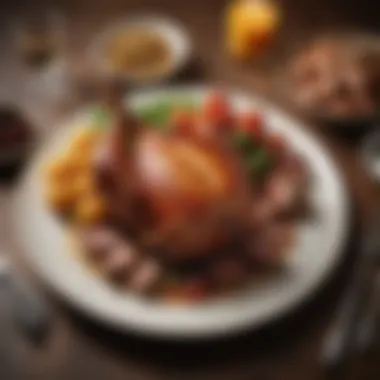
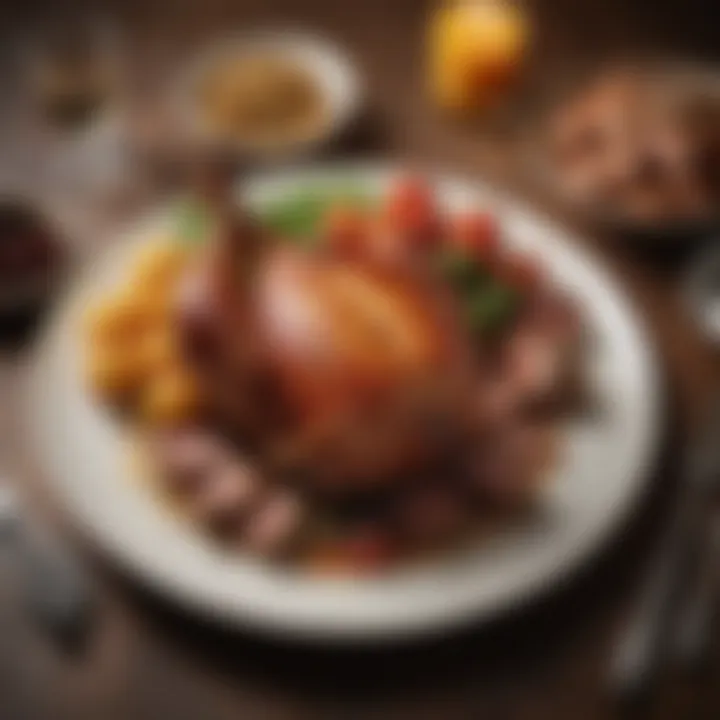
Traveling west to Latin America, the vertical rotisserie technique is prominently featured in the preparation of the famous al pastor. This dish melds Mexican and Middle Eastern influences, showcasing how culinary traditions can intermingle and transform.
- Preparation Differences: Al pastor traditionally uses pork marinated in a blend of spices and pineapple, a nod to Mexico's unique flavor profile. The meat is stacked on a vertical spit, and the addition of a pineapple at the top allows juices to drip down over the cooking meat, creating a distinct sweet-savory flavor combination.
- Tradition and Community: Like shawarma, al pastor is more than just a meal. Tacos al pastor are a staple at festive gatherings and local taquerías, bringing people together. It highlights the celebration of food, often served with fresh cilantro and onions, engaging diners to customize their tacos.
"Culinary practices are as much about the food as they are about the people and the stories they share. Vertical rotisserie spits do just that, bridging cultures and creating communal experiences."
In summary, both Middle Eastern and Latin American traditions underscore the versatility and cultural integration of vertical rotisserie spits. As we continue to explore these practices, it becomes evident that they are more than cooking methods; they are pivotal to communal identities, flavor experiences, and culinary legacies cherished worldwide.
Innovative Recipes Calling for Vertical Rotisserie Techniques
When it comes to vertical rotisserie cooking, one must not overlook the diverse and innovative recipes that can truly elevate the culinary experience. The adaptability of vertical spit cooking allows for a wide array of dishes, breaking traditional norms and pushing culinary boundaries. This section will delve into the importance of harnessing vertical rotisserie techniques, emphasizing how they can enhance flavors, promote creativity, and yield delectable dishes for those looking to impress.
Classic Recipes Revisited
Revisiting classic recipes is a smart way to appreciate the versatility of vertical rotisserie techniques. For instance, consider the timeless chicken shawarma. Traditionally cooked on a horizontal spit, using a vertical rotisserie brings a new spin—literally—on this beloved dish. The meat cooks evenly, allowing juices to drip down, creating a flavorful marinade which can soak the already tender meat.
The beauty of this method lies in the twist on flavors. Long marinating times with spices such as cumin and coriander combined with a slow cooking process results in an end product that not only tastes fantastic but looks inviting as well.
- Other examples include:
- Kebabs: Whether it's beef or lamb, skewering marinated meat on a vertical spit allows for optimal heat exposure and maintains the juicy texture.
- Gyros: Cooking gyro meat vertically ensures the crispy outer layer while keeping the inside moist.
Each of these recipes, adjusted for vertical rotisserie preparation, demonstrates how traditional dishes can grow in depth and character through cooking innovation.
Contemporary Innovations
Stepping into the realm of contemporary cooking, vertical rotisserie techniques inspire creativity far beyond traditional recipes. Consider using unique flavor combinations, such as a téquila-lime marinade for shrimp or an apple cider brine for pork. These flavors tend to thrive in a vertical setting, with the heat and rotation enhancing their profiles through consistent exposure.
Here are a few contemporary innovations worth exploring:
- Vegetable Skewers: Perhaps you think vertical cooking is just for meats? Nonsense! Consider an assortment of bell peppers, zucchini, and red onions. The even cooking creates a beautiful char that complements any dish.
- Pizza on a Spit: While unorthodox, placing a pizza atop a rotisserie can create a delightful crust with distinct char marks. Top with your choice of ingredients and let it slowly rotate until golden.
- Fruits for Desserts: Traditional grilling lends itself well to fruits. Pineapple, for instance, when cooked on a vertical spit, caramelizes beautifully. The flavor intensifies, making it a delightful end to any meal.
Vertical rotisserie cooking offers endless avenues for flavor exploration and culinary experimentation. With each turn of the spit, culinary ingenuity can shine through, transforming ordinary ingredients into extraordinary creations. Embracing these innovative recipes allows cooks of all levels to experience the joy of cooking while expanding their palate and impressing their guests.
Challenges and Considerations in Vertical Cooking
The area of vertical cooking is not without its own set of challenges and considerations. While the advantages are many, such as even heat distribution and enhanced flavors, there are some hurdles to navigate that can impact the cooking process. Understanding these challenges can significantly improve cooking outcomes, ensuring that both novice and experienced chefs can wield vertical rotisserie spits effectively and confidently.
Time Management during Preparation
Time management plays a crucial role in vertical cooking. The technique itself may seem straightforward, but it demands attention to timing at various stages. From marinating meats to ensuring the appropriate setup of the spit, timing can make or break the dish. To illustrate, if a piece of meat is not marinated long enough, it won't absorb flavors adequately, leading to a lackluster result. Conversely, if chicken is left to marinate for too long, it can become overly salty or mushy. Proper planning is essential.
- Make a Schedule: Allocate specific time blocks for each stage of preparation. A breakdown might include marinating time, preheating the spit, and expected cooking duration.
- Use Timers: Digital timers can assist greatly with attention management, preventing overcooking or burning, especially since the meat only rotates slowly.
- Multitask Smartly: While the rotisserie is working its magic, be prepared with side dishes or sauces to complement your main course. This can lead to a well-coordinated meal that impresses without a hectic atmosphere.
Understanding Temperature Control
Temperature control is another serious consideration when working with vertical rotisserie spits. Getting heat just right isn't straightforward. Too high, and you risk charring the outside while leaving the inside undercooked. Too low, and the food may overstay its welcome on the spit, leading to dryness.
"It’s a balancing act, crucial for juicy, tender outcomes."
- Know Your Heat Source: Whether using electric, gas, or charcoal, understanding the output and how it interacts with your food is essential. Heat sources vary in intensity and can affect cooking time significantly.
- Use Meat Thermometers: These tools are invaluable in ensuring that the internal temperature of the meat reaches safe levels, vastly improving the chance of a successful dish.
- Adjust during Cooking: Keep an eye on the cooking process and be ready to adjust the spit’s position or temperature if things seem off. If something’s not working, don’t hesitate to make quick decisions.
In essence, becoming proficient in vertical cooking requires not just an appreciation for how it functions but also an understanding of the nuances of time and temperature. By mastering these aspects, cooks can unleash the full potential of vertical rotisserie spits, paving the way for remarkable culinary adventures.
Future Trends in Vertical Rotisserie Technology
As culinary expectations evolve, so too do the tools that chefs and home cooks utilize to prepare their meals. Upcoming trends in vertical rotisserie technology hold significant promise for enhancing cooking efficiency and flavor profiles. Understanding these trends can give both culinary enthusiasts and professionals the upper hand in leveraging innovative cooking methods, ensuring their dishes stand apart in an increasingly competitive environment.
Emerging Innovations
The realm of vertical rotisserie spits is on the cusp of various innovations. Manufacturers are stepping up their game, incorporating advanced technologies that not only aim to simplify the cooking process but also amplify the food's flavor. One such innovation is the integration of smart technology. Imagine being able to control the temperature and rotation speed from your smartphone, adjusting them according to the specific recipe while you prepare other ingredients.
Additionally, some new models feature infrared heating elements which promise to cook food more evenly while retaining moisture, leading to juicier meats and vegetables. Imagine placing marinated chicken on the spit and receiving a perfectly grilled piece every time, with those tantalizing juices locked in. Automatic self-cleaning mechanisms are also making waves, making the post-cooking cleanup a breeze—no more scrubbing away at the burnt-on remnants of your latest culinary adventure.
"Upcoming innovations aren't just about gadgets; they are about enhancing the very experience of cooking."
Sustainability Considerations
As the culinary landscape pivots towards a more eco-conscious approach, sustainability remains a pivotal discussion when it comes to vertical rotisserie technology. One of the primary focus areas is reducing energy consumption. Newer models are being designed with energy-efficient heating systems that use less power, thus lowering your carbon footprint without compromising on flavor or performance.
Moreover, the materials used in constructing these spits are gradually shifting towards sustainable options. Manufacturers are now exploring biodegradable and recyclable materials, making the cooking equipment eco-friendly. This change not only attracts environmentally conscious chefs but also contributes to a larger vision of sustainability.
The use of locally sourced materials for manufacturing is another emerging trend. By supporting local economies and reducing transportation emissions, we can enjoy not only flavorful meals but also contribute to a healthier planet.
In closing, adopting future trends in vertical rotisserie technology leads to more efficient, flavorful, and sustainable cooking experiences. With the ongoing advancements, chefs and home cooks alike can benefit from improved equipment that doesn’t just meet their needs but also aligns with contemporary values of health and environmental consciousness.
Epilogue: Embracing Vertical Rotisserie Spits in Home Cooking
Vertical rotisserie spits offer a unique avenue for home cooks to elevate their culinary game. Throughout this article, we have navigated the intricacies of these devices, understanding not just how they work, but why they deserve a prominent place in any kitchen. In a world of convenience foods and quick dinners, vertical cooking isn't just a method; it's a celebration of flavor and technique.
Summary of Key Takeaways
As we reflect on the essential aspects covered in this guide, a few vital points stand out:
- Flavor Depth: Vertical rotisseries create a self-basting effect. As the meat cooks, juices drip down, continuously flavoring and moistening the lower cuts.
- Health Benefits: This cooking method allows fat to drip away, contributing to healthier meals without sacrificing taste.
- Versatility: Whether it's a succulent chicken, juicy lamb, or crisp vegetables, the vertical spit can cater to a wide variety of ingredients, expanding your culinary repertoire.
- Cultural Richness: The global influence of vertical rotisserie styles—from Middle Eastern shawarma to Latin American al pastor—highlights diverse cooking traditions, making it a fascinating exploration for food lovers.
In summary, these key takeaways reinforce the idea that embracing vertical rotisserie spits can significantly transform one's cooking experience.
Encouraging Experimentation and Exploration
The final message to take away from this comprehensive overview is one of exploration. Cooking is an art, and like any art form, it thrives on innovation and personal expression. Vertical rotisserie spits invite creativity in preparation and flavor combinations.
Imagine not just sticking to meats; experiment with spices, marinades, and even fruits or desserts. Could pineapples be caramelized on a vertical spit? What about a rotating rack of seasoned vegetables basking in the flavors of slowly rendered meat juices?
Food lovers of all ages should feel inspired to dive into this cooking method. Not only can it rekindle the joy of cooking at home, but it also brings an opportunity for gatherings with friends and family centered around this delightful culinary experience.
To wrap it up, embracing vertical rotisserie spits is about much more than just cooking; it’s about cultivating our culinary identity and passion. It's about transforming the everyday meal into something extraordinary, where each rotation tells a story and each flavor transports us to far-off places. So why wait? Fire up that spit and get roasting—the world of flavor awaits!







